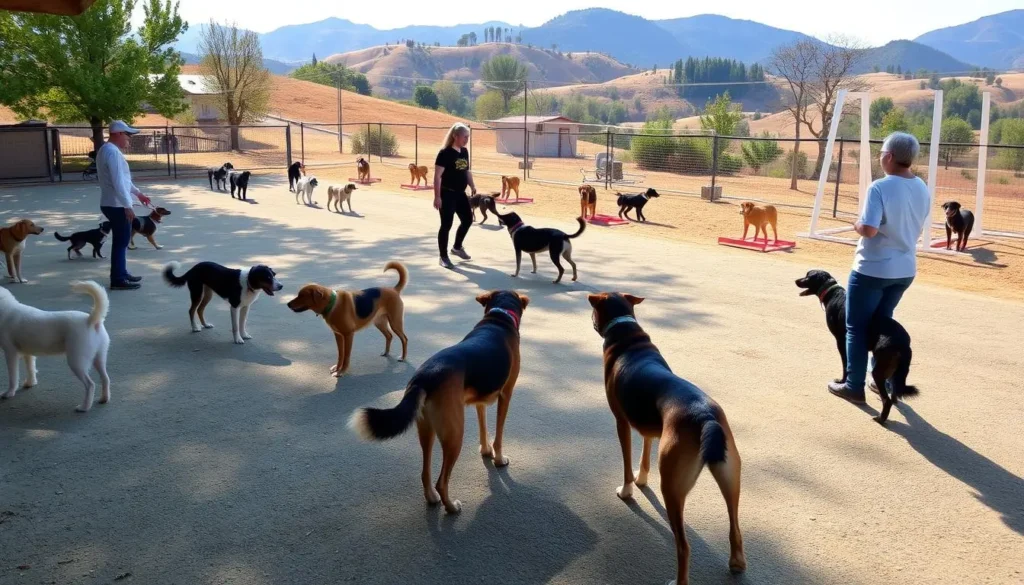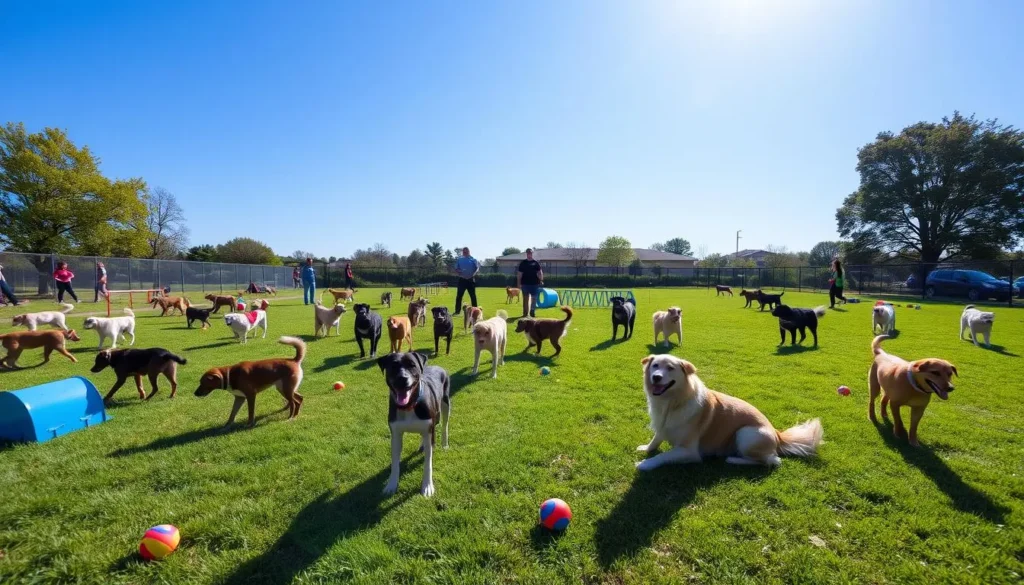Finding the right dog training can feel overwhelming. But, a dog board and training program can make it easier. These programs give your dog the care and training they need in a fun place.
These programs have a team of experts ready to help your dog. They focus on obedience, solving behavior issues, and social skills. You’ll know your dog is in good hands.
Starting this journey with your dog means knowing what to expect. From the first check-up to daily updates, it’s all about your dog’s happiness and your peace of mind. Learning about these programs helps you make the best choice for your pet.
Table of Contents
Understanding Dog Board and Training: An Overview
Board and train programs help enhance your dog’s behavior and obedience skills.They offer a structured environment for your dog to learn essential skills. By understanding the benefits, duration, and training methods, you can see how these programs can help your dog.
Benefits of Professional Training Programs
Enrolling your dog in a board and train program has many advantages. Skilled trainers utilize proven methods to tackle a range of behavioral issues. Your dog will learn better impulse control, socialization skills, and a stronger bond with you.
Duration and Commitment Requirements
Board and train programs last from two to six weeks. During this time, your dog stays at the training facility for daily instruction and care. The temporary separation is worth the long-term benefits of a well-trained dog.
Types of Training Methods Used
These programs use different training methods, like positive reinforcement and clicker training. Trainers work with your dog to address problematic behaviors and teach essential skills. This combination helps your dog develop a wide range of abilities.
Investing in a board and train program can be life-changing for you and your dog. Understanding the benefits, commitment, and training methods helps you decide if it’s right for your dog. With professional guidance, your dog can grow and learn, strengthening your bond and improving your life together.
Evaluating if Board and Train Is Right for Your Dog
Choosing the right boarding and training for your dog is key. It’s important to think about what will work best for your pet. This ensures a good experience for both you and your dog.
Start by looking at your dog’s age and personality. Young dogs do well in dog bootcamp training. They learn important skills like obedience and how to get along with others. Older dogs might need help with specific problems.
- Think about your dog’s energy and any bad habits, like barking too much or jumping up.
- Also, consider how much time you can give to the program. Many dog boarding and training plans need you to be involved and practice with your dog.
It’s also important to check how the program trains dogs. Look for places that use positive methods. Avoid places that might hurt your dog’s feelings or your relationship with them.
“The key to a successful dog boarding and training experience is finding a program that aligns with your dog’s unique needs and your own goals as an owner.”
Considering these factors can help you determine if a board and train program is the right choice for you and your dog. Spending time and money now can lead to a happier, better-behaved dog. This makes your life more enjoyable.

The Initial Assessment and Program Selection Process
Choosing a dog board and training program starts with a key step. This step is the initial assessment and program selection. It’s all about recognizing and understanding your dog’s individual needs. This ensures they get the care they need.
Behavior Evaluation Components
The first thing is a detailed behavior evaluation. Trained professionals check your dog’s temperament and obedience level. They also look at any behavioral challenges your dog might have.
This evaluation might include watching your dog in different situations. They might test how your dog reacts to certain things. They also ask about your dog’s past and current behavior.
Customizing Training Goals
After the evaluation, trainers work with you to set specific goals. These goals could be to improve obedience or address certain behaviors. The goal is to make your dog’s training as effective as possible.
Health and Safety Requirements
- Your dog must meet certain health and safety standards before starting. This includes being up-to-date on vaccinations and not having contagious diseases.
- The training facility also has strict rules to keep all dogs safe and healthy.
- These rules help create a safe and healthy place for your dog to learn and grow.
This thorough process ensures your dog gets the right dog board and training. They will become a well-behaved and confident friend.
Daily Life at Dog Training Camp
Putting your dog in a training camp is a big step. It’s an opportunity for them to learn and grow.But what happens every day at the camp? Let’s explore the daily life of a dog training camp.
The day starts early with a wake-up call and breakfast. This gives your dog the energy for the day. Then, they start learning important commands and behaviors with the help of skilled trainers.
After breakfast, dogs get to play and exercise. This is important for their social skills and confidence. They engage in supervised play with other dogs.
After playtime, dogs have lunch and rest. Trainers might work on specific issues or give individual training during this time.
- The afternoon is for more training and learning new things.
- Dogs get to move around and play outside often.
- The day ends with a final training session and dinner.
The camp’s daily routine is full and fun for dogs. They learn, play, and get to exercise. This helps them grow and become better dogs.
| Time | Activity |
| Early Morning | Wake-up, Breakfast |
| Mid-Morning | Training Session, Play/Exercise |
| Midday | Lunch, Individual Training |
| Afternoon | Training Session, Outdoor Time |
| Evening | Final Training, Dinner |
Knowing what happens at a dog training camp makes you feel good. Your dog is in a safe place, learning and growing. They’ll become the well-behaved dog you’ve always wanted.

Core Skills and Behaviors Taught During Training
When your dog joins a dog board and training program, they start a big journey. These programs teach them important skills and behaviors. Your dog will learn to obey commands and make friends, becoming a better pet.
Obedience Command Training
Dog training focuses on teaching obedience commands. Your dog will learn to do things like “sit,” “stay,” and “come.” They’ll become more disciplined and attentive, making your life easier and safer.
Behavioral Modification Techniques
Training also helps fix bad behaviors like barking too much or pulling on the leash. Trainers find the cause of these problems and teach your dog better ways to act. This makes your dog happier and more well-behaved.
Socialization Practices
Socialization is key for your dog’s happiness and safety. In training, they meet other dogs and people in a safe place. This helps them feel confident and friendly, making them a great addition to your family.
By choosing a good board and training program, your dog will become well-trained and social. They’ll be ready to enjoy life with you and make friends.
Owner Involvement and Training Sessions
Your active role in your dog’s board and train program is key to success. You’ll learn how to handle your dog and see their progress. This helps you understand the training methods and how to keep up the good work at home.
The training facility will keep you updated and offer hands-on sessions. These sessions help you practice commands and manage any challenges. They also strengthen your bond with your dog. This way, you’ll know how to keep your dog’s good behavior going.
Good board and train programs need good communication and teamwork. Your active participation and eagerness to learn are crucial. They help ensure your dog’s behavior improves over time, making your relationship with them better and stronger.
FAQ
What is a dog board and training program?
A dog board and training program is a detailed training solution. Your dog resides at a professional facility for a duration of 2 to 4 weeks. They get intensive, one-on-one training from skilled handlers.
This training focuses on obedience, behavior change, and social skills.
What are the benefits of a professional dog training program?
Professional dog training programs offer many benefits. They help your dog learn faster and change behaviors. They also offer personalized training and improve your bond with your dog.
These programs provide structure and consistency. They help your dog’s behavior changes last at home.
How long do dog board and training programs typically last?
Dog board and training programs usually last 2 to 4 weeks. The program’s length depends on your dog’s needs and the behaviors being worked on.
What types of training methods are used in board and train programs?
Board and train programs use positive reinforcement and clicker training. They also use marker-based techniques. The goal is to make learning fun and rewarding for your dog.
How do I know if a board and train program is right for my dog?
Choosing a board and train program depends on your dog’s age and temperament. It also depends on the behaviors you want to change. Think about your dog’s needs and your training goals.
Consider if you’re ready to commit to the program and ongoing training.
What happens during the initial assessment and program selection process?
The initial process includes several steps. First, a behavior evaluation to find your dog’s strengths and weaknesses. Then, training goals are set based on your dog’s needs and your goals.
Finally, health and safety requirements are reviewed to ensure your dog’s well-being during the program.
What is a typical day like at a dog training camp?
A typical day at a dog training camp is structured. It includes training sessions, exercise, socialization, and rest. Your dog will do individual and group training and play with other dogs.
What core skills and behaviors are taught during dog board and training programs?
Dog board and training programs teach many skills. They focus on obedience commands like sit, stay, and come. They also work on behavioral modification and socialization.
This helps your dog become more confident and friendly with people and other animals.
How are owners involved in the training process?
Owner involvement is key for the program’s success. During the program, you’ll learn how to handle your dog. This helps your dog adjust when they return home and keeps the training going.

